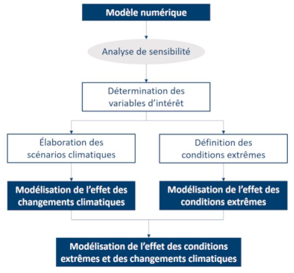Mine tailings site reclamation and climate change: development and application of adaptation tools
This methodological approach is applicable in different climates and for different reclamation methods. Mining industry stakeholders have a method to assess the resilience of present or future reclamation facilities in the face of climate change.
Project details
Principal(s) investigator(s)

The mining sector has many interactions with the surrounding natural environment. In Quebec, water management at mine sites and reclamation methods are the most vulnerable to climate change. Developing new methods to support the climate change adaptation of the mining sector and putting them into application in order to validate them is therefore necessary to make the mining industry more resilient to climate change, particularly with regard to site reclamation.
A previous study developed a methodological approach to integrate climate change into the evaluation of the performance of tailings storage facilities and reclamation methods with an oxygen barrier in a wet climate (Abitibi-Témiscamingue). These results must be added to (by taking vegetation into account, for example) and validated for other reclamation methods and in other climates to prepare Quebec mining sector stakeholders to adapt to climate change.
Photo: Mathieu Dupuis, site web - Mine Canadian Malartic
Objective(s)
-
To summarize the knowledge regarding the impact of climate change on the effectiveness of reclamation methods
-
To evaluate and improve the methodological approach in northern climates
-
To develop long-term vegetation scenarios taking climate change into account to complement the methodological approach
-
To assess the influence of climate change on the long-term performance of reclamation methods at abandoned or inactive sites
-
To disseminate information
Methodology
-
Updated literature review
-
Adaptation of the methodological approach used in wet climates to evaluate the effectiveness of mine site reclamation methods in the face of climate change for a reclamation method developed in a northern climate
-
Identification of vegetation scenarios for two mine sites (one active and one abandoned) in Abitibi-Témiscamingue
-
Evaluation of the methodological approach developed for wet climates for a recently reclaimed mine site (New Calumet, Quebec)
-
Dissemination of information acquired in pursuing the other objectives (conferences, MOOCs, scientific articles)
Results
The updated literature review summarized the current state of knowledge on the impacts of climate change on the mining industry. The methodological approach developed for wet climates (see figure) was:
-
Applied to another site in a wet climate; the reclamation method using a cover with capillary barrier effect was determined to be viable in the face of climate change in that study
Validated for another climate: adaptation of the parameters to be taken into consideration for a reclamation method with an insulating cover in a northern climate
Completed in a wet climate with a description of the scenarios for the progression of the spatial distribution of the different plant species found at two mine sites in Abitibi-Témiscamingue (the active Westwood site and the abandoned Lorraine site)

Figure: Diagram of the methodological approach used to integrate climate change into the design of mine reclamation facilities.
The results obtained in this project complement previous studies carried out on the climate change adaptation of tailings storage facilities. All of this knowledge was shared in conferences. In addition, a MOOC composed of five parts, each presented by an expert, allows a wide audience to acquire the essential knowledge to better understand the influence of climate change on the mining sector in general and more specifically on the management of mine waste storage areas, surface water management and mine site reclamation, including the revegetation of mine sites.
Benefits for adaptation
Benefits for adaptation
This methodological approach is applicable in different climates and for different reclamation methods. Mining industry stakeholders have a method to assess the resilience of present or future reclamation facilities in the face of climate change.
These results can reach a wide audience and raise awareness among decision-makers in the field as well as a less expert audience through the MOOC.
Scientific publications
Funding




Other participants
-
Polytechnique Montréal
-
Ouranos
-
Université de l'Alberta